Discovered in Jinyun County, China, in 2008 and officially described in 2018, Jinyunpelta sinensis (“Jinyun shield from China”) hails from the Albian-Cenomanian age, which at around one hundred million years is the oldest age of the Late Cretaceous. This makes it the oldest and baselmost ankylosaurine known to date. In addition, it is the oldest one confirmed to have possessed a tail club.

I purchased the Vitae Jinyunpelta for a relatively good price from a vendor called Lana Toys on Amazon.com, whom I’d previously used to acquire PNSO toys. Much to my chagrin, when the parcel arrived, the contents inside had been damaged. And I do mean significantly damaged. The vegetation on the display base had crumbled into bits, a number of the ankylosaur’s scutes and toes were broken, and its left front leg had broken clean off as well. Damnation.
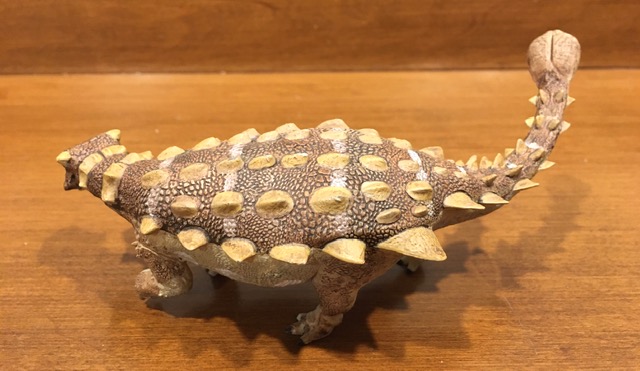
Lana Toys very generously gave me a refund, but the Jinyunpelta was long out of stock. I’d really been looking forward to owning a replica of both a very significant ankylosaur and a genus whose name begins with the letter J (they’re pretty darned rare!), plus I wasn’t sure I’d be able to find another one at the same price. So I got out some super glue, tweezers, and a strong lamp, recovered as many broken bits as I could find, and carefully stuck them back onto the figure. I think I did a fairly decent job, although I wasn’t able to recover a couple of the front toes and the tip of one of the scutes along the right flank. No hope of repairing the plants on the base, though.
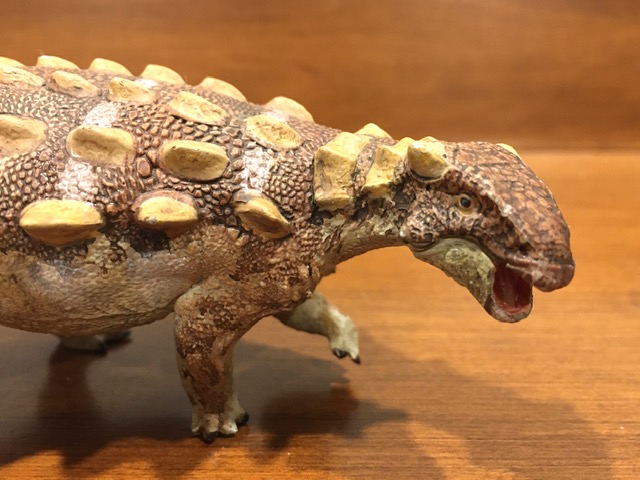
The Jinyunpelta is sculpted with its head turned to the right, its mouth wide open, its left forelimb raised, its right hind limb extended back, and its formidable tail raised and swinging to the right. It could be enthusiastically enjoying a morning constitutional or it could be growling defiantly and pointing its tail club at an enemy. It measures 15 cm long, making it too large to be in scale with the likes of the Safari Ltd. and PNSO Ankylosaurus figures. Fortunately, scale has never bothered me that much.
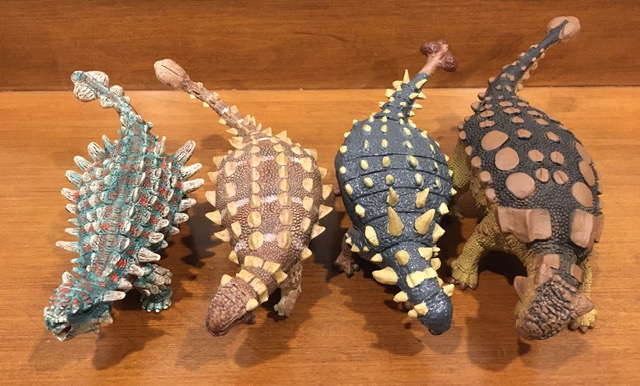
The base colour on the top half of this ankylosaur is a shade of medium brown with dark brown wash to bring out all the tiny osteroderms comprising the armour. White stripes run across the back, although their application varies from faint to bold, which is somewhat displeasing. The tail club and the many scutes are a lighter brown while the head features tiny black eyes and glossy salmon pink for the inside of the mouth. The Jinyunpelta’s bottom half, meanwhile, is beige with white splotches. Medium brown splotches cover the limbs, which terminate in very dark brown claws. It’s one of the latest in a long line of brown ankylosaur toys, but it looks decent. I could have definitely done without the white, though. Vitae also produced a red “low tech” version which I wasn’t even aware of when I started working on this review.
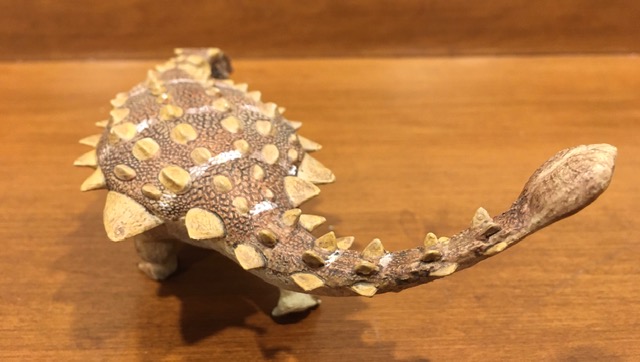
The Jinyunpelta’s sculpting is really top notch. Its ventral side is covered mostly in a pitted texture with minimal wrinkles, nothing extraordinary there. The limbs and flanks are more impressive, with their fine pebbled scales. But it is the countless little osteoderms making up the armoured hide on the animal’s back that really make it shine. They aren’t just intricately sculpted; they vary noticeably both in terms of size and shape. More so than on many other superb ankylosaur toys that have come out recently. As well, the large scutes and the tail club all have a pitted texture for additional realism.
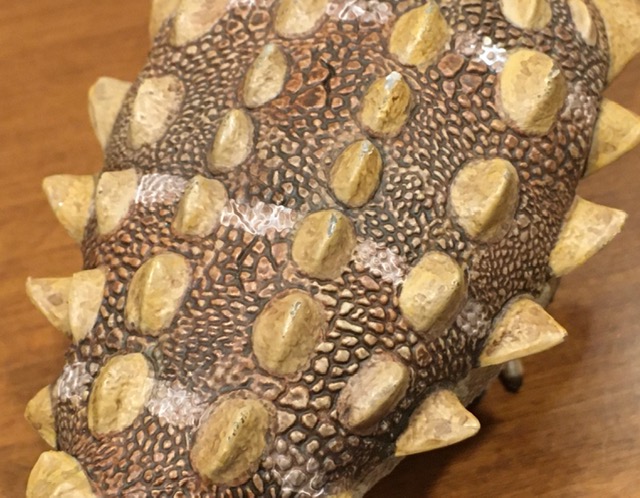
It is also clear that the sculptor did their research into Jinyunpelta‘s appearance. The limbs are relatively short with five digits on each of the front feet and three on the hind ones. The trapezoid-shaped head is narrower than that of younger ankylosaurids, features relatively small squamosal and jugal horns, and despite being armoured, is relatively smooth on top. The neck is protected by two sections of fused scutes, the back features four rows of keeled scutes, and the flanks have rows of flatter, more blade-like ones. The tail club is longer than it is wide, although looking at the images in the paleontological description, the tip ought to be flatter. The relatively large size of the club may indicate that Jinyunpelta coexisted with at least one large and dangerous theropod, although no such beast is presently known from the Liangtoutang Formation where the former was discovered.

The accompanying display base is 19.5 cm long with a maximum width of 8.5 cm. As I mentioned before, it was originally adorned with some small and rather delicate green plants, but those were all destroyed during shipping. They appear to have been similar to the fake plants you often see decorating model railways, so perhaps someday I’ll be able to visit to the hobby store and see what I can find to replace them.

As it presently stands, this looks like just a patch of dry and parched earth painted in varying shades of brown, but it is still very well-sculpted. The bottom is covered with a black felt pad, which is also nice.
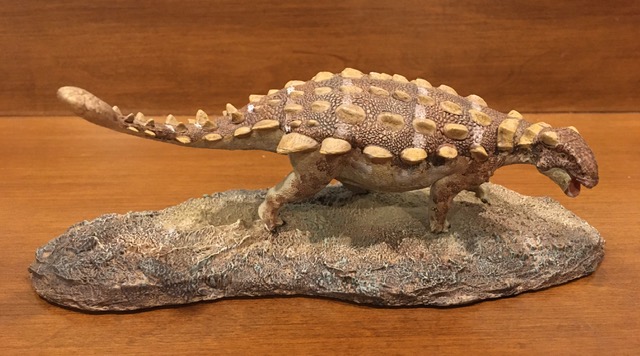
The Vitae Jinyunpelta is a well-researched and beautifully sculpted rendition of a relatively obscure and intriguing dinosaur, and as I noted before, it’s one of the very few prehistoric toys whose name begins with J. I’d say all that certainly justifies the purchase. That said, the plastic quality does appear to be more brittle than that of other companies. In addition to my own experience, I’ve heard a few similar stories from other collectors about their Vitae products arriving in the mail with bits broken off. So you’re probably well-advised to be cautious about who you order your Jinyunpelta from. Hopefully yours will reach you fully intact. You’ll be sure to enjoy it!
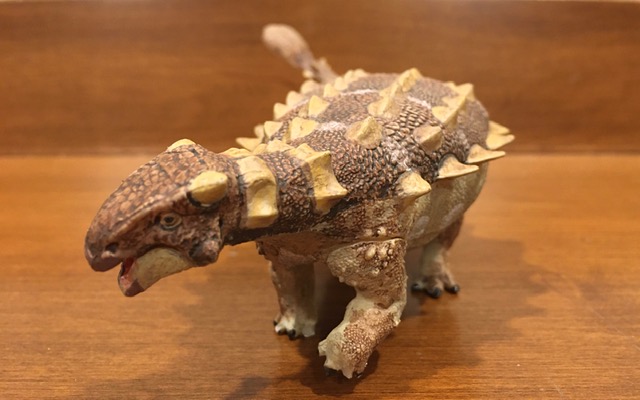
Support the Dinosaur Toy Blog by making dino-purchases through these links to Ebay and Amazon. Disclaimer: links to Ebay.com and Amazon.com on the Dinosaur Toy Blog are often affiliate links, when you make purchases through these links we may make a commission

Great review of this interesting creature. Too bad about the damage but it looks like you did a good job restoring it.
So, is the material pvc or resin?
The toy itself is PVC and the base is resin.
Magnificent figure, one hundred percent recommended! He didn’t know he was such a scientific figure. Honestly, that makes me like it a lot more. I also did not know that the figure of the jinyunpelta was as brittle as you say and the same I say about the base. I have it on a table in the living room and that makes me take note to prevent it from breaking and having to order another figure of that great ankylosaur. Figure totally recommended.
this figure reminds me of the PNSO Sede ankylosaurus figure, although Sede is 9 inches long and this is about 6.
It’s a very ankylosaurus looking ankylosaur, for being the earliest known, which I find surprising.
La tengo y es muy bonita, la pose natural me gusta y combina muy bien con su pariente el ankylosaurus PNSO, Vitae es una gran empresa y me alegra de sobremanedera que hayan vuelto y espero sigan por mucho tiempo, tienen mucho para dar a los amantes de los dinosaurios en poses más espontáneas
you did a great job at restoring this great figure.
Big 10 out of 10. K also would one day find one of these figures for myself. Regards.
Merci!
Looks like the gluing was effective. Mine was ordered from the Model Toy Shop, though I do order from Lana more frequently. It arrived massively protected along with its fellow release, the Tianaiosaurus, and therefore with no damage, for which I’m grateful. Great review, as always. I wish that you still did more of them – I like the quality of the content and the style, which is both personal and objective.
Thanks!